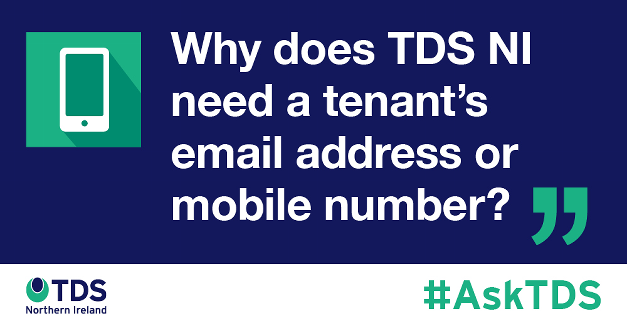#AskTDS: “Why does TDSNI need a tenant’s email address or mobile number?”

This article has been written in response to a tenant’s query: “Why does TDSNI need my email address or mobile number?”
When a landlord or agent registers a tenancy deposit with TDSNI, they must input some basic information about the tenancy; this includes the property address, deposit amount and the tenancy start and expected end dates as well as information about each tenant. When adding information about tenants on the TDSNI Custodial website, the landlord or agent must add contact details (either an email address or mobile number) for each tenant to allow TDSNI to contact them. The email address input for the tenant is not only the means we use to communicate with them, but it becomes a tenant’s username to log in and view their tenancy deposit certificate and also submit a repayment request once the tenancy ends. Where there is more than one tenant, each tenant will need their own email address or mobile number. A single email address cannot be duplicated for multiple tenants.
Within the TDSNI Custodial Scheme, where only a mobile number is supplied, TDSNI are able to text or write to the tenant to both confirm the deposit is protected and to request that they activate their account for raising or responding to a repayment request at the end of the tenancy.
Once a tenancy comes to an end, either party can inform TDSNI that the tenancy has ended and request the return of the deposit. In order to release the deposit money, both parties must confirm agreement of any deductions. In TDSNI’ experience, where contact details are up to date the return of the deposit can be seamless as the parties are more likely to respond. Without the relevant contact details at the end of the tenancy, TDSNI can only write to the tenancy address and if the tenant does not receive this correspondence they may miss the opportunity to get the deposit returned.
In the TDSNI Insured Scheme, should the parties be unable to reach an agreement on the return of the deposit, either party can raise a dispute with TDSNI. If a landlord or agent reaches the end of the tenancy and has no means to contact the tenant, by law TDSNI cannot adjudicate. If the missing party cannot be contacted within 3 months, the only alternative is to go through court so it is important to ensure all contact information is accurate.
Who does TDSNI communicate with when there are multiple tenants?
For properties and tenancies involving joint tenants, all tenants should be added to the deposit protection and have details entered on the TDSNI database. TDSNI uses a lead tenant model, meaning only the lead tenant can raise or respond to repayment requests or deal with the administration relating to a dispute. If you wish to change the lead tenant, you must discuss this with your landlord or agent.
About TDSNI:
Tenancy Deposit Scheme Northern Ireland (TDSNI) is a government approved scheme for the protection of tenancy deposits; we offer both insured and custodial protection. We also provide fair adjudication for disputes that arise over the tenancy deposits that we protect.
